Exhibition – Life and Legacy: Dorothy Hogg(1945-2022)
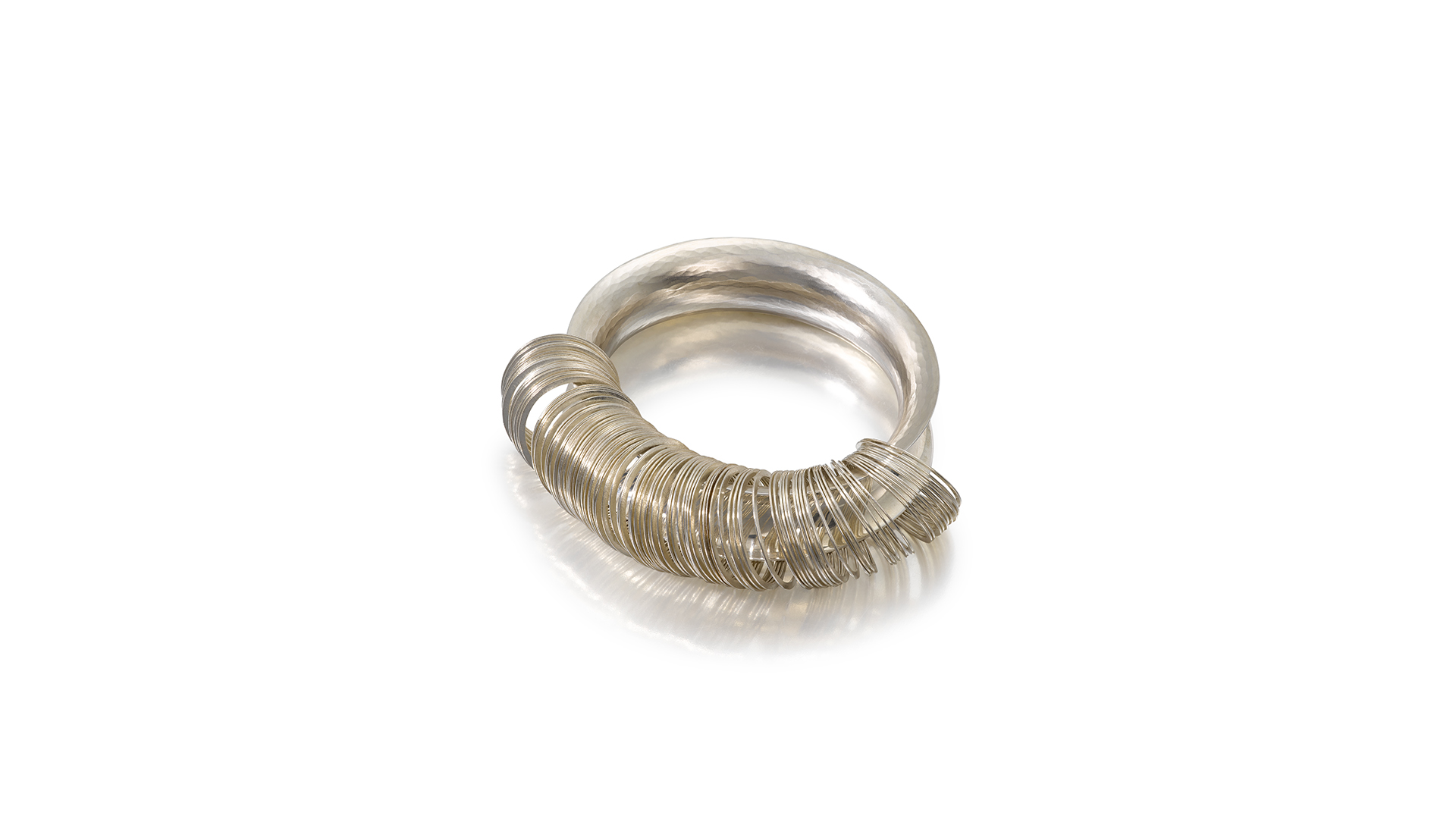
Professor Dorothy Hogg MBE, the outstanding Scottish craftsman and teacher who died in 2022, changed the world of jewellery and silversmithing. A preeminent artist jeweller and a Freeman of the Goldsmiths’ Company, Hogg produced lyrical jewellery of extreme precision and great beauty. Her work is held in many major international collections. The Goldsmiths’ Company is privileged to have, in its Modern Jewellery Collection, perhaps
the most significant body of her work in a single collection in terms of its quality, range and provenance, which is currently on display in the ‘Life and Legacy: Dorothy Hogg’ exhibition.
Hogg also leaves a vibrant legacy as a teacher. She was Head of the Department of Silversmithing and Jewellery at Edinburgh College of Art (ECA) for almost a quarter of a century, from 1985 to 2007. Under her guidance, and supported by talented colleagues,
the department developed one of the best design courses in the UK. Hogg’s students regularly won prizes and awards, and in 2001 she received an MBE in recognition of her services to silversmithing and jewellery. The impact of her teaching reverberates still across the field of contemporary metalworking; every year a significant number of her
alumni exhibit at Goldsmiths’ Fair, and a great number now have pieces of their own in the Company Collection. Many of those Hogg taught are now teachers themselves, working across the UK but especially in Scotland.
The ‘Life and Legacy’ exhibition at Goldsmiths’ Hall celebrates Hogg as a jeweller in her own right and honours her legacy as a teacher. The first exhibition case shows a wide range of Hogg’s own jewellery, alongside pieces by several silversmiths who taught her as a student, and jewellery by her long-term Edinburgh colleague Susan Cross. The second case exhibits the work of Hogg’s alumni, together with that of current Edinburgh and Glasgow staff and graduates. The fact that all the pieces on display, bar a few key loans, are drawn from the Company’s Collection is a testament to Hogg’s lasting impact on contemporary jewellery and silversmithing.
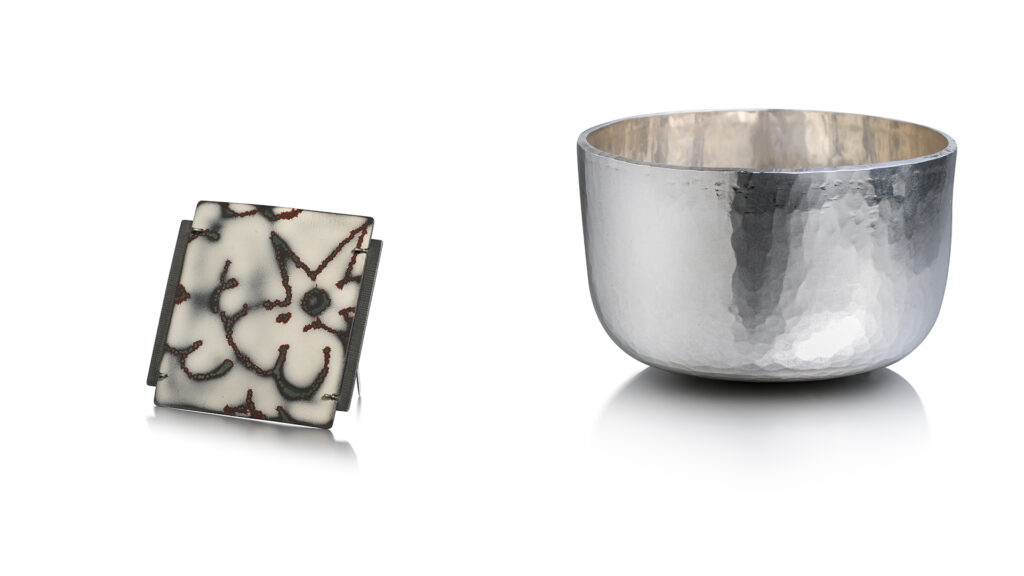
In 1963 Hogg joined Glasgow School of Art, specialising in silversmithing and jewellery. The department was run by silversmith J. Leslie Auld, whom Hogg described as ‘an extraordinary teacher’. The talented Scottish silversmith William Kirk, to whom Hogg referred as a ‘Renaissance man’, taught her engraving. Hogg often described herself
as ‘a silversmithing jeweller’, and the silversmithing education she received at Glasgow had a clear influence on her jewellery. Behind its deceptive simplicity, it is meticulously engineered. There are pieces by both Auld and Kirk in the Company Collection and in the ‘Life and Legacy’ exhibition, including a sublime, diminutive hand-raised silver cup by Kirk. We are also lucky enough to be able to display a rare student piece by Hogg, on loan from the Pearson Silver Collection – a silver tea strainer and stand she made
at Glasgow with ‘Dorothy Hogg 1965’ scratched on the bottom.
On graduating from Glasgow in 1967, Hogg began a three-year Master of Design degree at the Royal College of Art (RCA). During her time there she worked with blue plique-à-jour enamel and angular, sculptural forms, ‘which reflected the tension I was experiencing at being transplanted from a small Scottish town to the centre of metropolitan London and studying within a very competitive institution’. She also worked with anodised blue titanium, and the Company is thrilled to have in its Collection, and on display, a silver and titanium ring from this period which Hogg herself wore.
On graduating from the RCA, Hogg returned to Scotland in 1972 and completed a teaching degree. She taught part-time back at Glasgow and in Dundee, but her life changed in 1985 when she became Head of the Department of Silversmithing and Jewellery at ECA: ‘When I got the job at Edinburgh, I just thought “I know what to do here”.
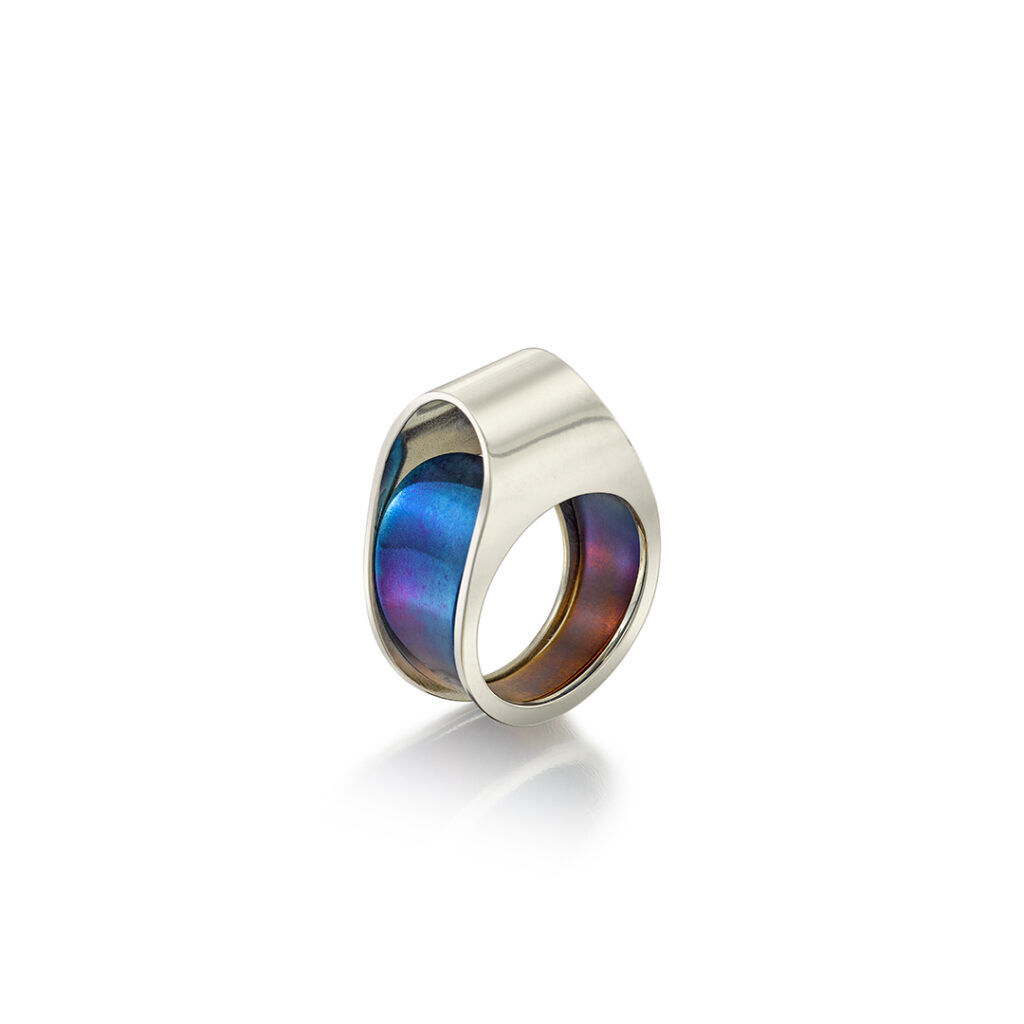
Hogg was assisted by formidably talented colleagues at Edinburgh, including William Kirk and Susan Cross. Together, the three were known to their students as ‘The Holy Trinity’. Cross, an established studio jeweller, still teaches part-time at ECA. The four outstanding examples of her work in the Company Collection, all on show in the exhibition,express her fascination with historic textiles and the translation of textilemaking techniques to metalwork. In 2007 Cross received the Jerwood Applied Arts Award for Jewellery, and she is exhibiting in the Fair this year.
The Edinburgh course under Hogg and her colleagues gained an outstanding reputation, attracting jewellers and silversmiths from abroad. Misun Won came from South Korea to study at ECA and has since established herself as an independent artist jeweller and regular Fair exhibitor. Her spectacular ‘Circular Ovals Flower Brooch II’, made in 2018 from pierced silver sheet and 18 carat gold Keum-boo, is inspired by the ritual movements of ‘Jogakbo’, a traditional Korean cloth-wrapping technique. It was acquired for the Company Collection in 2023 and is on display in the ‘Life and Legacy’ exhibition. As well as the strength of the ECA course, Won, like many others, was drawn by the warmth and generosity of Hogg’s personality.
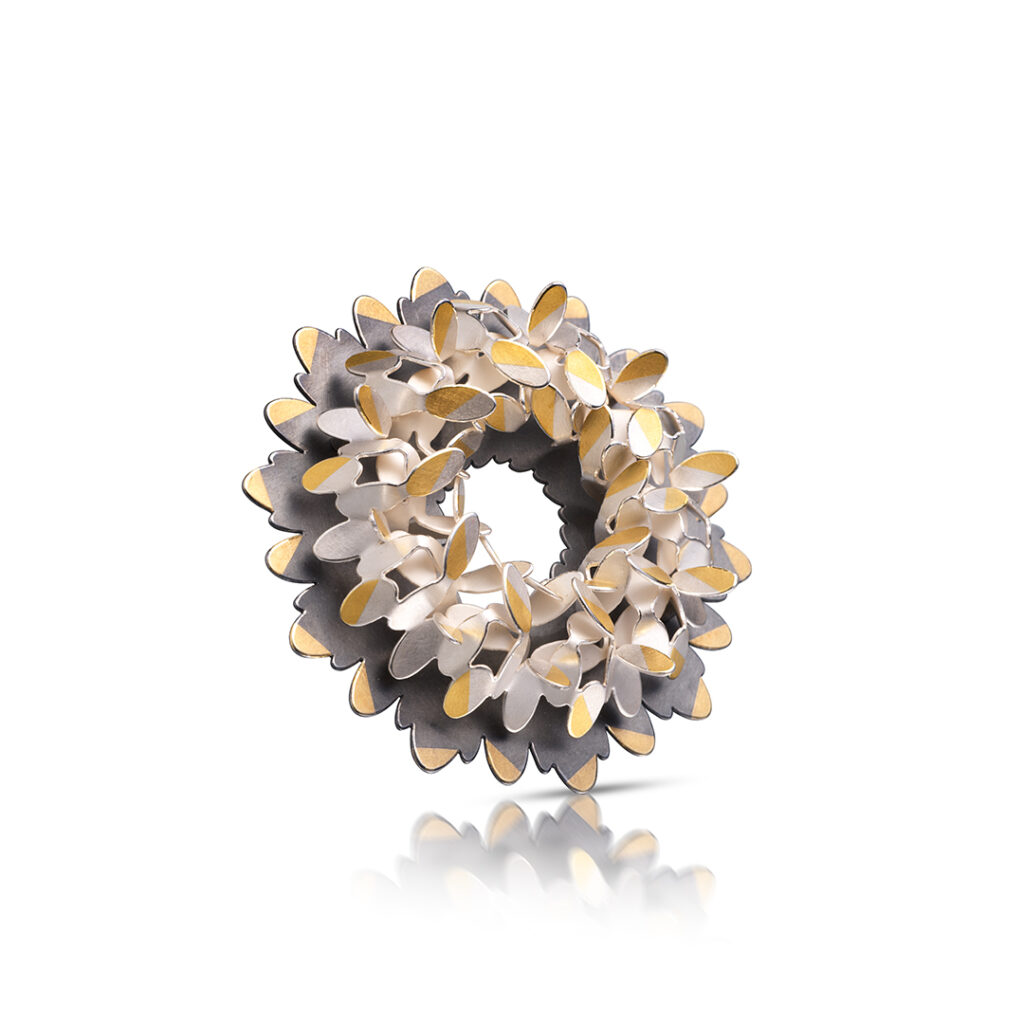
One of the many innovations Hogg brought to the ECA course was its outward, international focus. She invited leading makers and teachers from abroad including Oppi Untracht (1922-2008), Onno Boekhoudt (1944-2002) and Giovanni Corvaja (b.1971) to speak to the students and run masterclasses. She worked closely with National Museums Scotland, as well as the commercial Scottish Gallery, so that the
buzz she created around the Art College incorporated and drew in a wider cultural
field. She worked hard to fundraise and to secure work placements for her students in a wide range of institutions. She recognised the importance of preparing people for a sustainable career, whether in education, industry or independent design and making.
She introduced an Artist-in-Residence scheme, now widely emulated, whereby recent graduates were given a bench within the department in exchange for some teaching. It offered a series of now-significant makers their key first role after graduating. Following her retirement in 2007, Hogg herself became the first Artist-in-Residence at the Victoria and Albert Museum (V&A).
Hogg evolved a course that laid great emphasis on drawing and sketching, including life-drawing classes as well as hands on problem solving in different materials. Portfolio was the strand of the course which put observational drawing, in different forms, at the centre. It was a body of work which could take any form but was critically assessed and graded. British Sculptor Cathie Pilkington, currently Keeper of the Royal Academy Schools, began studying in the ECA Sculpture Department but transferred to Silversmithing and Jewellery with Hogg’s encouragement. In Pilkington’s words: ‘The workshops throbbed with energy, activity and possibility.’ Hogg said of Pilkington: ‘I knew it would be like having an unexploded bomb in the department, but she had such talent for drawing. And she was so focused on drawing and making that I just knew we had to kind of give her a space and see what happened.’ Pilkington’s playful ‘Jumping Jack’ medal, acquired this year, is on display in the exhibition
A great number of Hogg’s alumni are now themselves independent artist jewellers or silversmiths, including Grainne Morton and Cóilín Ó Dubhghaill. Several, such as Joanne Thompson and Grace Girvan, are exhibiting at the Fair this year. Many went on to become teachers themselves, often alongside their own making careers. Anna Gordon is now Head of the Department of Silversmithing and Jewellery at Glasgow, which, under her leadership, offers a preeminent design education. Two of her colleagues, Andrew Lamb, a fellow Hogg alumnus, and Marianne Anderson, are both successful studio jewellers and repeat Fair exhibitors. Gordon, Lamb and Anderson all have pieces in the Company Collection and the ‘Life and Legacy’ exhibition.
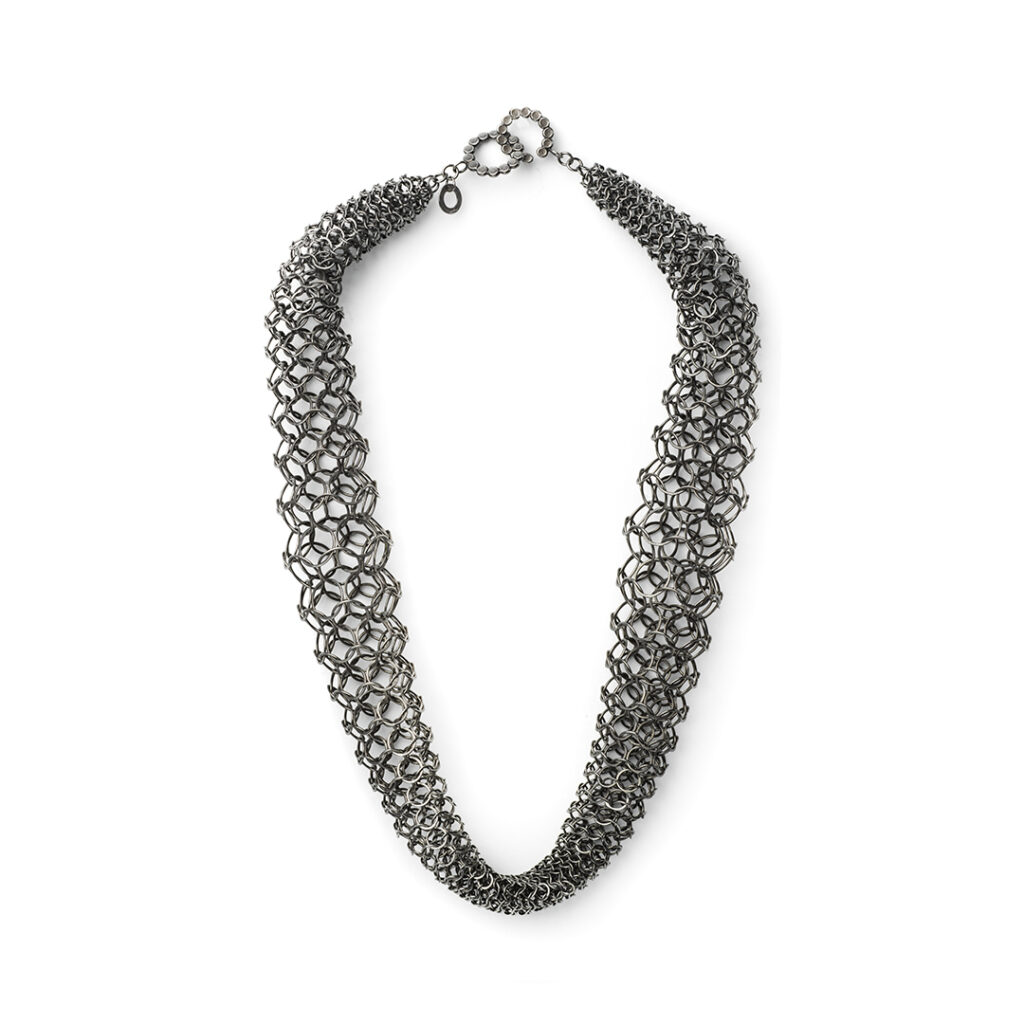
Other of Hogg’s alumni have become architects, academics, brand consultants and fine artists. Hogg’s educational legacy continues, therefore, right across the UK and beyond, but has a strong Scottish focus. Over the last few years, a growing number of pieces have been bought for the Company Collection from young makers exhibiting at the Fair, several for the first time, who were taught at ECA or GSA, including Elizabeth Jane Campbell, Sheng Zhang, Eleanor Whitworth and Megan Brown.
Despite the myriad demands of her Edinburgh role, Hogg herself managed
to continue making and exhibiting her own accomplished jewellery throughout her life. One suspects that only her own making, and the intensity of focus it required, enabled her to switch her thoughts and energies away from ECA: ‘When I sit down at my bench, I know I’m in the right place.’ The curator Dr. Elizabeth Goring described Hogg’s jewellery as ‘three-dimensional lyricism’. Hogg herself acknowledged that her own subconscious was the greatest source of her inspiration and she spoke often of a desire to make work that communicated where she was in life at the time. Hogg was represented by the Scottish Gallery throughout her career and had three major exhibitions there in 1994 and 2004, both organised with the then Director Amanda Game, and 2014, followed by the ‘Modern Heroine’ retrospective just before her death in early 2022.
The Company’s exceptional collection of Hogg’s jewellery has been acquired mostly over the last three years, and weare aware of the responsibility it brings. The exhibition forms part of a wider celebration of Hogg’s work, entitled ‘The Tree Project’, which has included a Study Day on Design Education that took place at the Goldsmiths’ Centre in June. Company Liverywoman Amanda Game and the Scottish Goldsmiths’ Trust have produced a series of podcasts featuring ECA alumni discussing the ways the design
education they received at ECA has enabled them to excel across diverse careers. In addition, Eleni Bide and Sophia Tobin in the Company Library have organised the digitisation of five of Hogg’s working notebooks, which she generously donated to the Company Archive in 2021.
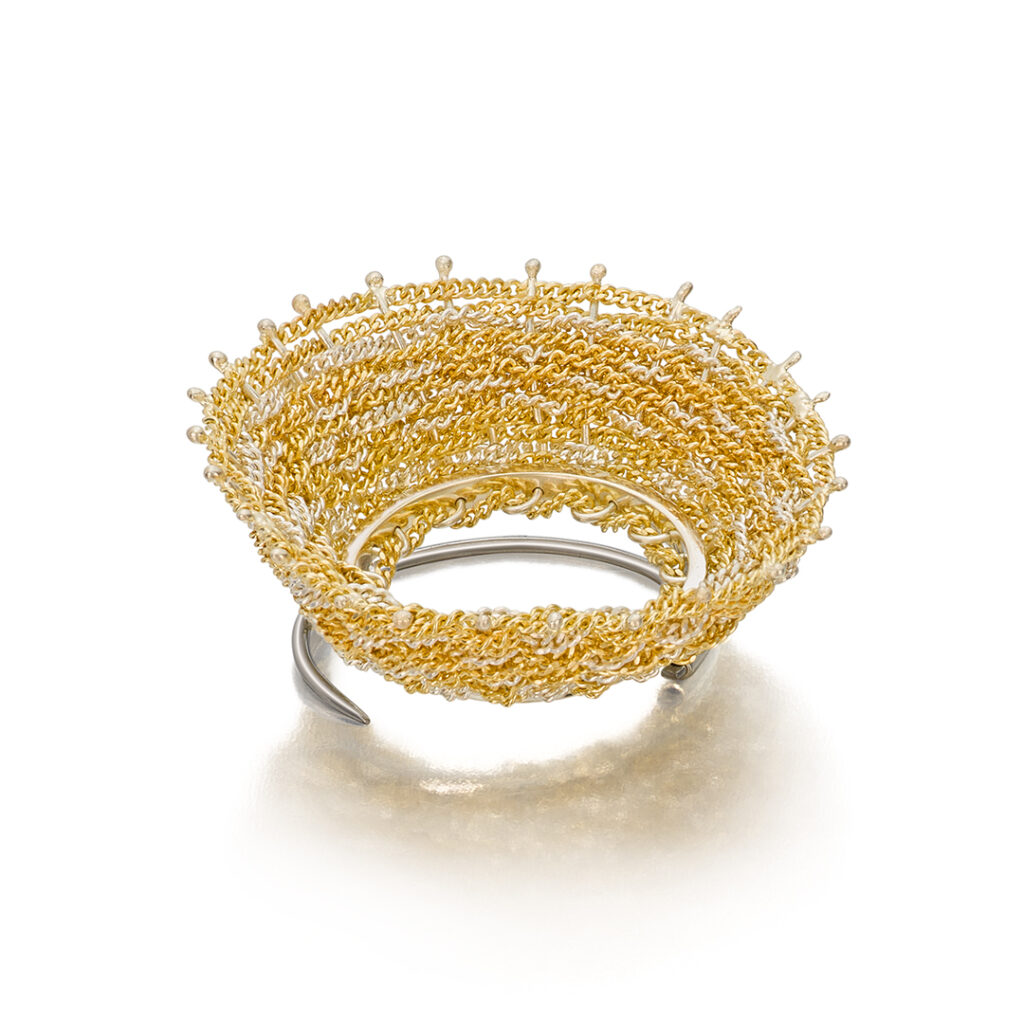
A publication celebrating Hogg’s legacy is also being launched during this year’s Fair. It features a full catalogue of the Company’s collection of Hogg’s work,together with that of her teachers, colleagues and alumni. It includes a foreword from journalist and curator Freeman Corinne Julius; an essay on ‘The Tree Project’ and Hogg’s influence as an educator by Liverywoman Amanda Game; a personal reflection on working with Hogg from her colleague Susan Cross; and contributions from contemporary artists and makers Katy Hackney, Anna Gordon, Andrew Lamb,Cathie Pilkington and Natalie Ryde, all of whom were taught by Hogg at ECA. Although Hogg’s ECA role demanded extraordinary focus and determination, she is remembered by those who knew her for her warmth and generosity. She was also funny and incredibly modest. With reference to the Company’s acquisitions, she stated: ‘I used to say to students it’s absolutely wonderful when a museum buys your piece, because, you know, it’s never going to end up in the washing machine.’
By Dr Frances Parton
With very many thanks to Lachlan MacColl, Lewis MacColl and Amanda Game, together with the exhibition lenders: Charlotte Dew, Maeve Gillies, Katy Hackney, Grainne Morton, The Pearson Silver Collection, and Natalie Ryde.
